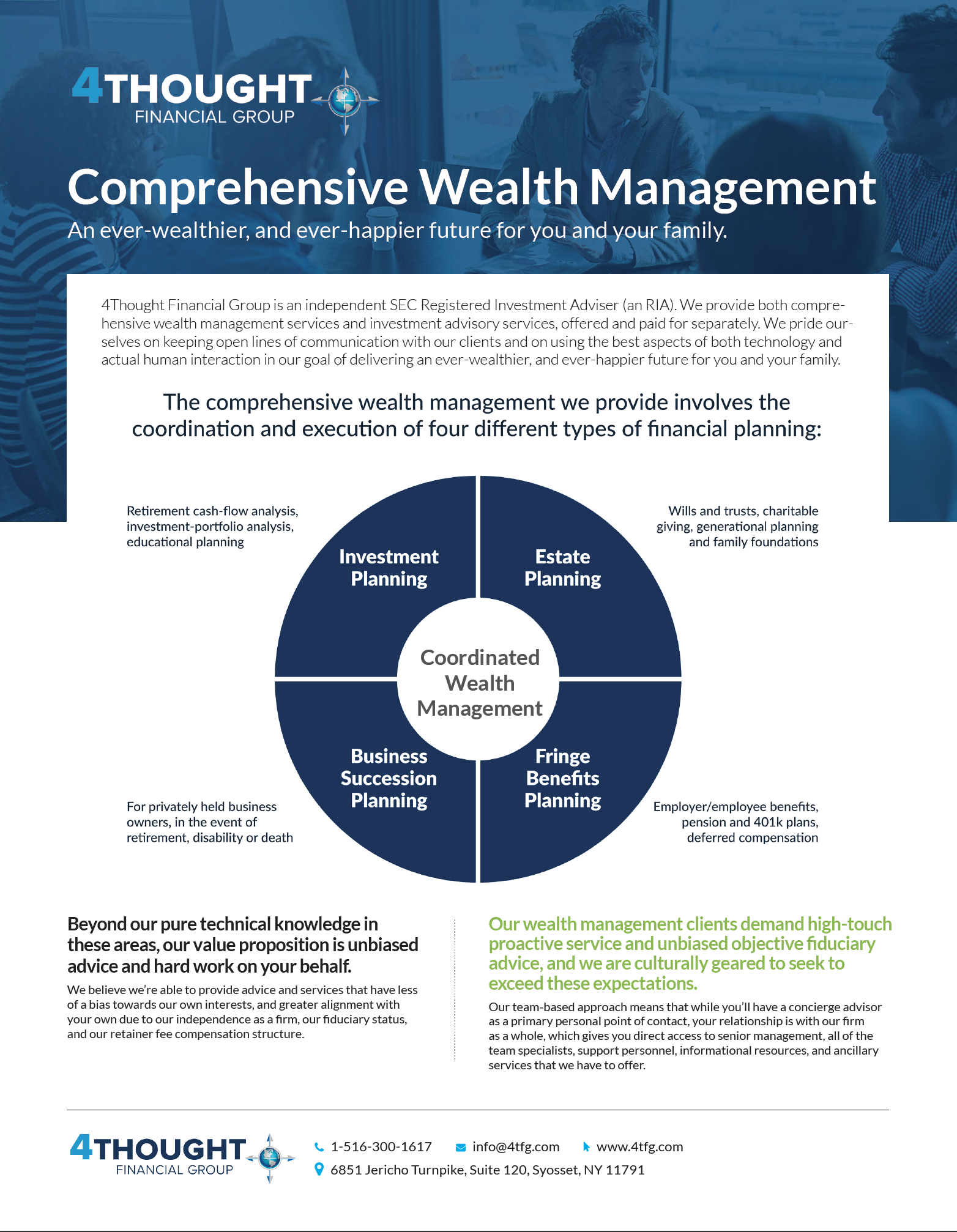

Wealth Management by 4Thought Financial Group
"The comprehensive wealth management we provide involves the coordination and execution of four different types of financial planning: Investment Planning, Estate Planning, Business Succession Planning and Fringe Benefit Planning."
(Co-authored by 4Thought Financial Group Operations Associate Michael C. Duvally)
The time is now for CPAs to step up to the plate and learn how their clients’ financial advisors are being compensated.
The financial services industry has not been up front or transparent about this historically. Now that the Fiduciary Rule by the U.S. Department of Labor (DOL) is in tatters, all compensation options are once again on the table. A recent client meeting proved onerous fees are still being charged and incentives are still misaligned in many cases.
Many financial advisors are representatives of both a Broker-Dealer and a Registered Investment Adviser (RIA) firm (usually owned by the broker-dealer or a parent insurance company). But the tide has turned following the publicity surrounding the DOL Fiduciary Rule and any pending potential legislation from the U.S. Securities and Exchange Commission (SEC). More advisors are going independent and practicing a “new school” of wealth management, not only in terms of their licensing/registration, but also in terms of their relationship with clients, by compensation through a retainer fee arrangement.
Our firm is an independent RIA. We are not owned by a larger institution, nor are we affiliated with a broker-dealer. As an RIA, by legal definition we are a fiduciary to our clients. As a fiduciary, we work in the best interests of the client, and not those of a broker-dealer. We also work on a retainer fee basis.
A new client (referred by a CPA) hired our firm to provide financial planning services. The client signed a financial planning agreement and agreed to pay us a monthly retainer fee. In this case, one of the spouses, age 63, was recently laid off from their job, and the CPA directed the couple to us for advice about the possibility of retiring.
The client had some concerns before hiring us about a 10-year-old revocable living trust brokerage account that was not making money. The clients had multiple brokerage accounts with a major wire house that included multiple registrations, including tax-deferred and taxable accounts. Their trust was a pass-through entity, taxed on the client’s personal income tax return.
Certain issues popped up after we reviewed their income tax return. Upon closer examination, line 13 of schedule D showed an approximate capital gain distribution of $25,500. The back-up statement for the income tax return showed that two of the taxable brokerage accounts generated capital gain distributions of approximately $7,000 from a joint account, and $18,500 from a trust account.
There were two trust-owned brokerage accounts. One was a managed advisory account being charged an annual asset-based fee of 1.55%, which held one municipal bond mutual fund with an expense ratio of .68%. (The latter is a hidden cost and not visible to the client.) The total cost to the client was 2.23%. The other trust brokerage account had five “C-share” mutual funds and four municipal bonds with no management fee. The C-share mutual funds had annual expense ratios ranging from 1.38% to 1.81% (also not seen by the client) for a weighted average total cost on $312,865 of $5,105 (or 1.63% per year).
In addition, the internal turnover rates of several of the mutual funds within the taxable accounts were generating tax liabilities. A turnover rate is the average percentage of a mutual fund’s internal assets (stocks and bonds) that are sold and reinvested during a one-year period. For example, the first C-share mutual fund had a turnover rate of 44%. This means that the stocks on average are held for 2.27 years (100/44 = 2.27 years). The turnover rates for the other C-share mutual funds were as follows: 45%, 28%, 36% and 20%.
When you add together the management fees ($18,767), the internal expense charges ($9,800) and the taxes generated from the turnover rate (25% capital gain rate times $25,500 or $6,375), annual costs were close to $35,000 on the entire portfolio, or 3.3% (on a portfolio of approximately $1,046,000). It’s unsurprising now why the client did not see much growth in the trust account. Most clients do not feel the tax hit directly on their portfolios from the capital gain distribution. When taxes are due they are commonly paid from a non-brokerage account, such as an ordinary checking or money market account. But either way, the taxes lead to a net effect, which detracts from their total overall wealth.
If exposure to a mutual fund with high turnover is desired, then a tax-deferred registration type (like an IRA) should own it, so that the capital gain distributions will not generate any additional unnecessary taxes. Any taxable trusts, that pay tax at the trust level, would have a higher tax bill on any capital gain distributions.
Accountants should either review client brokerage statements and cross reference them to the client’s personal income tax return or work with a professional that can do this analysis. In the previously mentioned case, we are sharing the financial planning retainer fee with the accountant. While the availability of this legal arrangement varies from state to state, regardless of state, the shared compensation with the accountant must be fully disclosed and signed off on by the clients, and a contract must be in place between the accountant and Registered Investment Adviser firm. Obviously, the sharing arrangement would not be available for an accountant performing an attest function for a business client.
The "old school" way of doing financial planning was to charge a one-time fee, with usually 50% down on signing of a financial planning agreement and the balance due upon completion of the plan. After completion of a conceptual plan, for implementation, the advisor might then sell commission products, such as mutual funds, variable annuities, or life insurance (as a registered rep of a broker-dealer and/or insurance agent). Then the relationship would dwindle over time, with any changes in the client’s life not being accounted for. Their financial road map (plan) would not be adapted to any changes unless regular review meetings were scheduled (which the advisor would have little or no incentive to do, because he/she had already been paid in full, up front).
The “new school” includes a better alignment of client goals with the advisor’s incentives. Wealth management charged on a retainer basis by an independent RIA, comparable to how business clients retain and pay you on a monthly (or quarterly) basis, should be the new norm. This allows for the continuous involvement of an advisor, and a greater propensity for the client’s financial road map to be adapted to any changes along the way.
The client is offered professional direction on their financial life by someone who has far less bias and is willing to highlight the pain points—with an actionable solution for each. A retainer fee reduces or eliminates the advisor’s need to sell unnecessary (potentially harmful/useless) products just to be compensated, and keeps them on the hook to continuously remain in contact with the client and update planning (because the client can simply stop paying if they think they aren’t getting their money’s worth). It also allows for greater advisor accountability by separating and differentiating any additional services offered (such as portfolio management or insurance brokerage) in the mind of the client. This separation of services, along with increased transparency and lower portfolio management/internal expense charges, should, in our opinion, be the future of financial planning and wealth management.
Attention to internal expense ratios and taxation has helped fuel the rise of Exchange Traded Funds (ETFs), which tend to offer greater tax efficiency when held by a taxable registration due to their typically passive index-tracking nature and their special tax treatment (permitted through the in-kind “creation/redemption” process). The rise of ETFs has further helped bring along the lowering of management fees, which has taken on greater significance with investment management fees no longer being deductible as a miscellaneous itemized deduction. These factors with the support of new technology and algorithmic portfolio management approaches are enabling financial advisors to offer professional money management with lower investment minimums, including in 401(k) and other retirement plans.
The tidal wave of changes in the financial services industry has provided a great opportunity for accountants to continue and enhance their reputation as the most “trusted advisor.”
Below is a summary of different advisor compensation structures:
Transaction/Product-Based Commissions
A broker or salesperson provides commission-based product solutions to clients, and gets paid based on the number and/or amount of transactions made for the client. This type of compensation is most appropriate for one-off situations, such as a stand-alone life insurance purchase or speculative individual stock trade, but if a client requires ongoing unbiased advice and more comprehensive services, this is usually not the best solution, as it is laden with conflicts of interest.
Assets Under Management (AUM) Fee
An investment manager/advisor provides fiduciary services in exchange for a fee based on a fixed annual percentage of the investment portfolio being managed for the client. This fee structure aligns the incentives of the advisor well with the goals of the investor when it comes to pure investment management and growing the portfolio, but when applied to broader wealth management, it provides no compensation or incentive for the advisor to work on estate planning, employer/employee benefits, or business-related planning (even if they say they are going to do this for you).
One-Time Fee
A fiduciary financial planner or wealth manager constructs a financial plan for a singular payment (typically paid half up front and half on delivery of a plan). While this goes a long way toward ensuring the advisor will look at multiple planning aspects and maintain an unbiased perspective, it provides no incentive for ongoing advice and updating the planning after the initial plan is delivered.
Retainer Fee
A fiduciary financial planner or wealth manager constructs a financial plan and updates it with ongoing advice perpetually for a monthly or quarterly fixed dollar amount fee. This provides the benefit of having the advisor look at all planning aspects from an unbiased perspective (not just investment management), and provides an incentive for him/her to continuously update the planning and provide advice for as long as the client continues to pay the fee. Often an initial living expense and budgeting analysis alone can improve cash flow enough to more than offset the cost of the monthly fee.
Combinations of All the Above
Some advisors/firms may use more than one of the above methods to provide the best arrangement to service the client’s particular scenario.








Leave a Comment